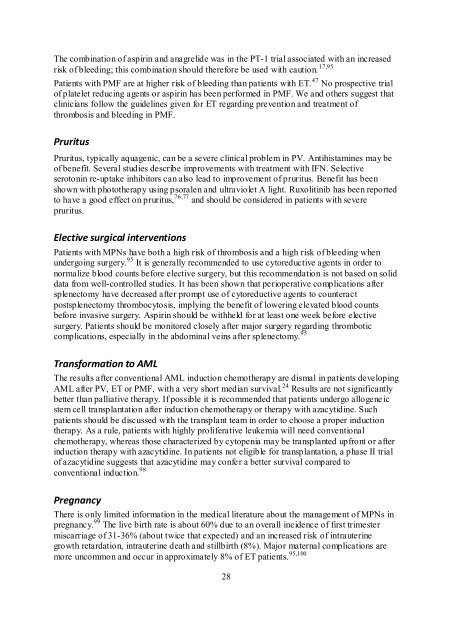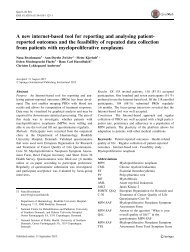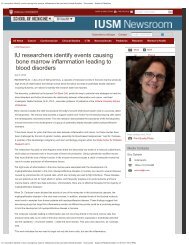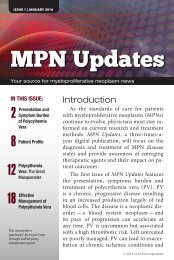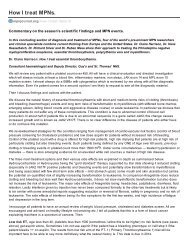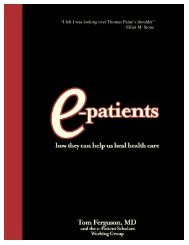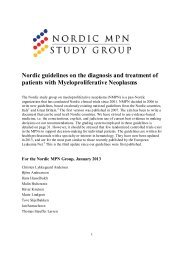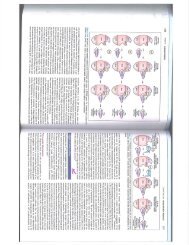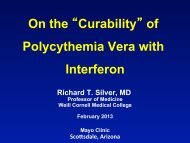NMPN_guidelines_2013.pdf
Create successful ePaper yourself
Turn your PDF publications into a flip-book with our unique Google optimized e-Paper software.
The combination of aspirin and anagrelide was in the PT-1 trial associated with an increased<br />
risk of bleeding; this combination should therefore be used with caution. 17,95<br />
Patients with PMF are at higher risk of bleeding than patients with ET. 47 No prospective trial<br />
of platelet reducing agents or aspirin has been performed in PMF. We and others suggest that<br />
clinicians follow the <strong>guidelines</strong> given for ET regarding prevention and treatment of<br />
thrombosis and bleeding in PMF.<br />
Pruritus<br />
Pruritus, typically aquagenic, can be a severe clinical problem in PV. Antihistamines may be<br />
of benefit. Several studies describe improvements with treatment with IFN. Selective<br />
serotonin re-uptake inhibitors can also lead to improvement of pruritus. Benefit has been<br />
shown with phototherapy using psoralen and ultraviolet A light. Ruxolitinib has been reported<br />
to have a good effect on pruritus, 76,77 and should be considered in patients with severe<br />
pruritus.<br />
Elective surgical interventions<br />
Patients with MPNs have both a high risk of thrombosis and a high risk of bleeding when<br />
undergoing surgery. 95 It is generally recommended to use cytoreductive agents in order to<br />
normalize blood counts before elective surgery, but this recommendation is not based on solid<br />
data from well-controlled studies. It has been shown that perioperative complications after<br />
splenectomy have decreased after prompt use of cytoreductive agents to counteract<br />
postsplenectomy thrombocytosis, implying the benefit of lowering elevated blood counts<br />
before invasive surgery. Aspirin should be withheld for at least one week before elective<br />
surgery. Patients should be monitored closely after major surgery regarding thrombotic<br />
complications, especially in the abdominal veins after splenectomy. 95<br />
Transformation to AML<br />
The results after conventional AML induction chemotherapy are dismal in patients developing<br />
AML after PV, ET or PMF, with a very short median survival. 24 Results are not significantly<br />
better than palliative therapy. If possible it is recommended that patients undergo allogene ic<br />
stem cell transplantation after induction chemotherapy or therapy with azacytidine. Such<br />
patients should be discussed with the transplant team in order to choose a proper induction<br />
therapy. As a rule, patients with highly proliferative leukemia will need conventional<br />
chemotherapy, whereas those characterized by cytopenia may be transplanted upfront or after<br />
induction therapy with azacytidine. In patients not eligible for transplantation, a phase II trial<br />
of azacytidine suggests that azacytidine may confer a better survival compared to<br />
conventional induction. 98<br />
Pregnancy<br />
There is only limited information in the medical literature about the management of MPNs in<br />
pregnancy. 99 The live birth rate is about 60% due to an overall incidence of first trimester<br />
miscarriage of 31-36% (about twice that expected) and an increased risk of intrauterine<br />
growth retardation, intrauterine death and stillbirth (8%). Major maternal complications are<br />
more uncommon and occur in approximately 8% of ET patients. 95,100<br />
28


